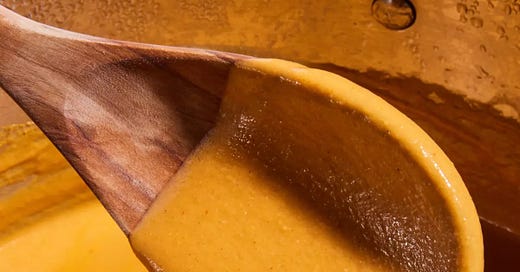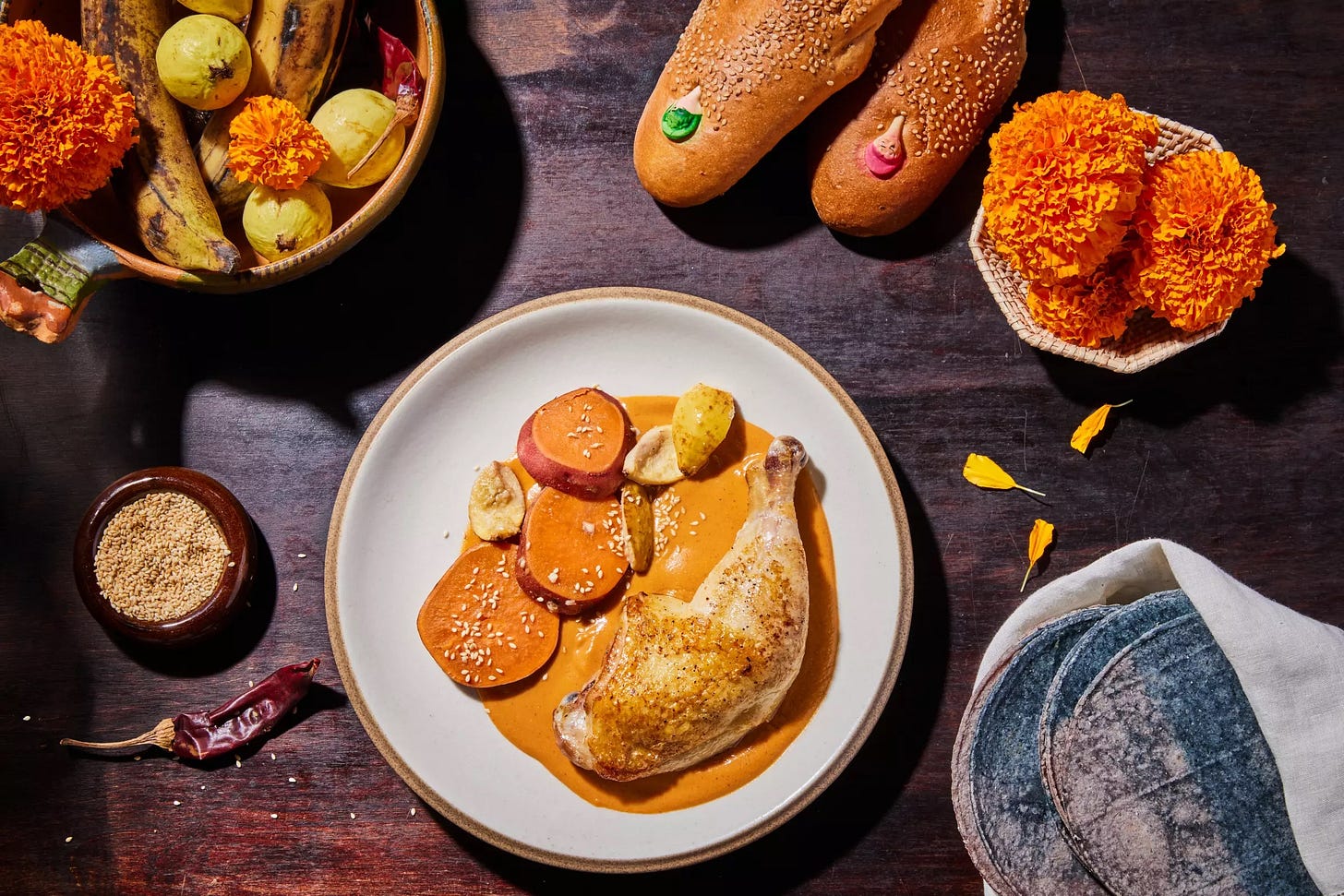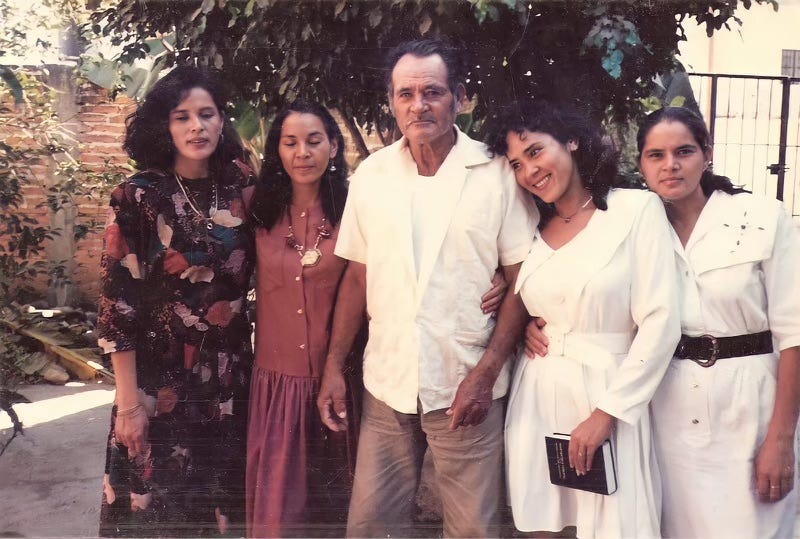A tropical mole for Día de Muertos to honor my abuelo
Plus, the secret to crackly, golden chicken skin.
Recipe by Paola Briseño-González For The Times / (Andrea D’Agosto / For The Times; Prop Styling by Jennifer Sacks / For The Times; Food Styling by Julie Giuffrida / Los Angeles Times)
Thick foam and up to their elbows in suds, families tidy up and decorate graves at cemeteries everywhere in Mexico as they prepare to celebrate Dia de Muertos. I can hear the swooshing and the scrubbing of the crypts as they get ready to honor their departed ones.
In my latest for The Los Angeles Times, I write about how the celebration originates in Indigenous cultures dating back thousands of years. It is derived from the rituals of prehispanic people in Mexico. In Aztec culture, death was transitory, and the souls of the dead could return to visit the living.
Like many Angelenos who immigrated to the United States, death is a constant reminder of our loved ones back in the motherland. We are often so far away that we might miss their deaths. They might miss ours.
When my grandfather, Heriberto González Sánchez, died in 2011 at the ripe old age of 102 years old, I had many regrets. I felt the sorrow of leaving my family behind, a deep regret of missing my grandfather’s last years, and a broken heart over the memories of our trips to the river to cool off from the relentless summer heat. Mi abuelo Beto, as we lovingly called him, ate cold corn tortillas with membrillo – quince paste – and a piece of raw milk queso fresco while we dipped our feet in the refreshing and cooling river water.
“Corn tortillas are just as good eaten cold,” he’d say to me.
I felt understood by him. I felt so loved by him. He used to sit me down and ask, why did you leave Mexico and your family behind to live alone in El Norte? He’d always end the conversation by telling me he’d be waiting for my return to Mexico—the land where I belong.
He started to slowly die the day he wasn’t allowed by his doctor and all of his eleven daughters to go to his rancho and care for his land situated along the edge of the Horcones River in Puerto Vallarta. He needed a pacemaker.
He lived the rest of his days at home and died surrounded by his daughters and grandchildren.
I said goodbye to him when he was on his deathbed. I called him on the phone from the U.S. They said he opened his dark green eyes one last time when he heard my voice.
Heriberto González with a few of his eleven daughters.
My abuelo Beto is on my altar every year. Altars are structures for Día de Muertos that honor ancestors and departed loved ones, with offerings of photographs, food, beverages, flowers, and other symbolic objects that represent their most treasured memories. They are said to invite the spirits of the dead back into the world of the living, welcoming them with an ofrenda.
Tropical fruits like guava, papaya and guanábana filled my abuelo’s patio. My offering to him is a reflection of the things he loved: the cold tortillas, the membrillo paste, the queso fresco, the bright red jamaica (hibiscus flowers), and tropical fruits.
This year, I’ll have a big pot of mole de guayaba for his ofrenda, inspired by his bustling garden in his paradise.
Smooth sauce: This guava mole has the consistency of melted ice cream. (Andrea D’Agosto / For The Times; Prop Styling by Jennifer Sacks / For The Times; Food Styling by Julie Giuffrida )
Mole, from Náhuatl mōlli, means sauce. The term is used interchangeably for a number of sauces, some quite different from each other, including mole negro, rojo, Camarillo, and manchamanteles, to name a few of the famous Oaxacan styles. There is pipián, a mole verde common in Zacatecas and Jalisco bursting with brightness because it is made with tomatillos and thickened with ground pepitas. Or the more casual mole de olla, a mole for everyday meals made with dried chiles and chock-full of vegetables like green beans, corn, squash, xoconostle (sour prickly pear), and chunks of tender beef. You eat it like a stew.
Mole de frutas are regional moles that use seasonal fruits as the main flavor profile. They are lighter and fragrant. The mole de guayaba that I make for my ofrenda starts with fruity guajillo chiles that are toasted and then rehydrated. The jammy guajillos are combined with blistered tomato, onions, and garlic. The mixture is thickened with sesame seeds, and perfumed with poached guavas, oregano, cinnamon, and crushed cloves. Overripe plantain is added to create the silkiest of textures, when you pour it, the mole looks like melted ice cream.
It is said that the scent of marigolds, often called cempasúchil or flor de muerto (flowers of the dead) is believed to attract souls to the altar. They represent the sun and act as a guide for the souls of the dead to return home.
I hope that the scent of this mole de guayaba guides my abuelo home to Mexico. But not before making a stop in El Norte to visit me so I can finally tell him that his death taught me how to live.
Start the chicken in a cold skillet and then turn up the heat, so the fat slowly renders and the skin turns golden brown and crispy. The crackly layer of skin keeps the tender meat juicy. The chicken is finished in an oven with sliced sweet potatoes and seeded guavas. It’s as simple as a roast chicken gets. Or keep it classic and serve this mole with boiled chicken, or a slow-roasted salmon, if you love fish like me.
Mole de Guayaba with Crispy Chicken and Roasted Sweet Potatoes
Serves 6 to 8
Ingredients
Your subscription of $5/month covers my ridiculous grocery expenses, so many hours of recipe development, testing, and what turns into Javier’s endless lunches, plus all of the resources that go into creating Fresca for you. Thank you for supporting my work.








